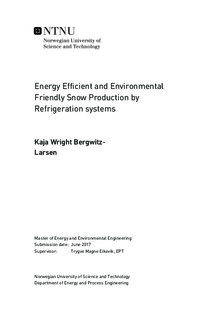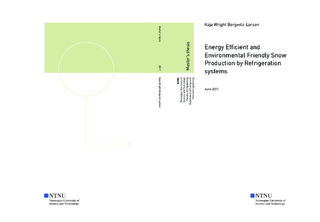| dc.description.abstract | In the light of increasing global temperatures, the winters tend to be shorter and milder, with the periods of natural snow being drastically reduced. In order to counter the challenges of climate changes and maintaining good skiing conditions in the winters to come, snow production equipment that can operate in ambient temperatures above 0 °C will be important for future applications. Such technology exists today, but it is expensive and highly energy-intensive; with an excessive amount of surplus heat that is released to the surroundings and thus wasted. In this thesis, methods to increase the energy efficiency of the snow producing equipment is explored; by integrating different snowmaking technologies with combined refrigeration and heat recovery systems. Use of environmental friendly refrigerants is highlighted.
An outdoor flake ice system with a production of 100 tons/day is modelled in EES and implemented with a transcritical CO2 process for heat recovery. By optimizing the gas cooler pressure, the heat recovery potential is increased compared to the pre-study. Integration of a coaxial heat exchanger yields the best thermodynamic performance; with maximized COP and close temperature approach. This approach offers the possibility of reduced demand of the intercooler and suction gas heat exchanger. The calculations in COMSOL validates the assumptions in EES. It emphasizes the importance of correct design of the flake ice drum and points to the need of an optimization process; in order to ensure efficient heat transfer characteristics.
Analysis shows that an air refrigeration cycle is unsuitable for indoor snow production. Simultaneous design for a large refrigeration load, high temperature and high relative humidity, yields an extensive mass flow and saturation below the freezing point, and icing in the expander cannot be avoided. An indoor transcritical CO2 cycle is seen to have superior thermodynamic performance at the dimensioning conditions. The system is easily adaptable, and provides highly energy efficient refrigeration and heating, without a simultaneous drop in the efficiency of the snowmaking process. While two-stage compression is required for the flake ice system due to the low evaporation temperature, one-stage compression can be applied to obtain the same heat duty in an indoor system. The flake ice drum suffers from the influence of melting of the snow in the pile during production, while this feature is negligible when production occurs in an indoor controlled environment. Indoor snowmaking is considered more space demanding and expensive, but with a better thermodynamic performance of the combined heating and refrigeration system.
The thermodynamic analysis points to indoor snow production combined with the transcritical CO2 refrigeration cycle and heat recovery by DHW heating as the best solution for the site. I have reviewed previous relevant studies and models developed at NTNU. The theories, conclusions and models developed through my work make it possible to approach a practical application for energy efficient and environmental friendly snow production and thereby fulfill the ambitions within the scope of Snow for the future . Some further analysis is however required before drawing a final conclusion, and the results should be seen in combination with total costs and models for snow melting and climatic impact on production rates. | |

